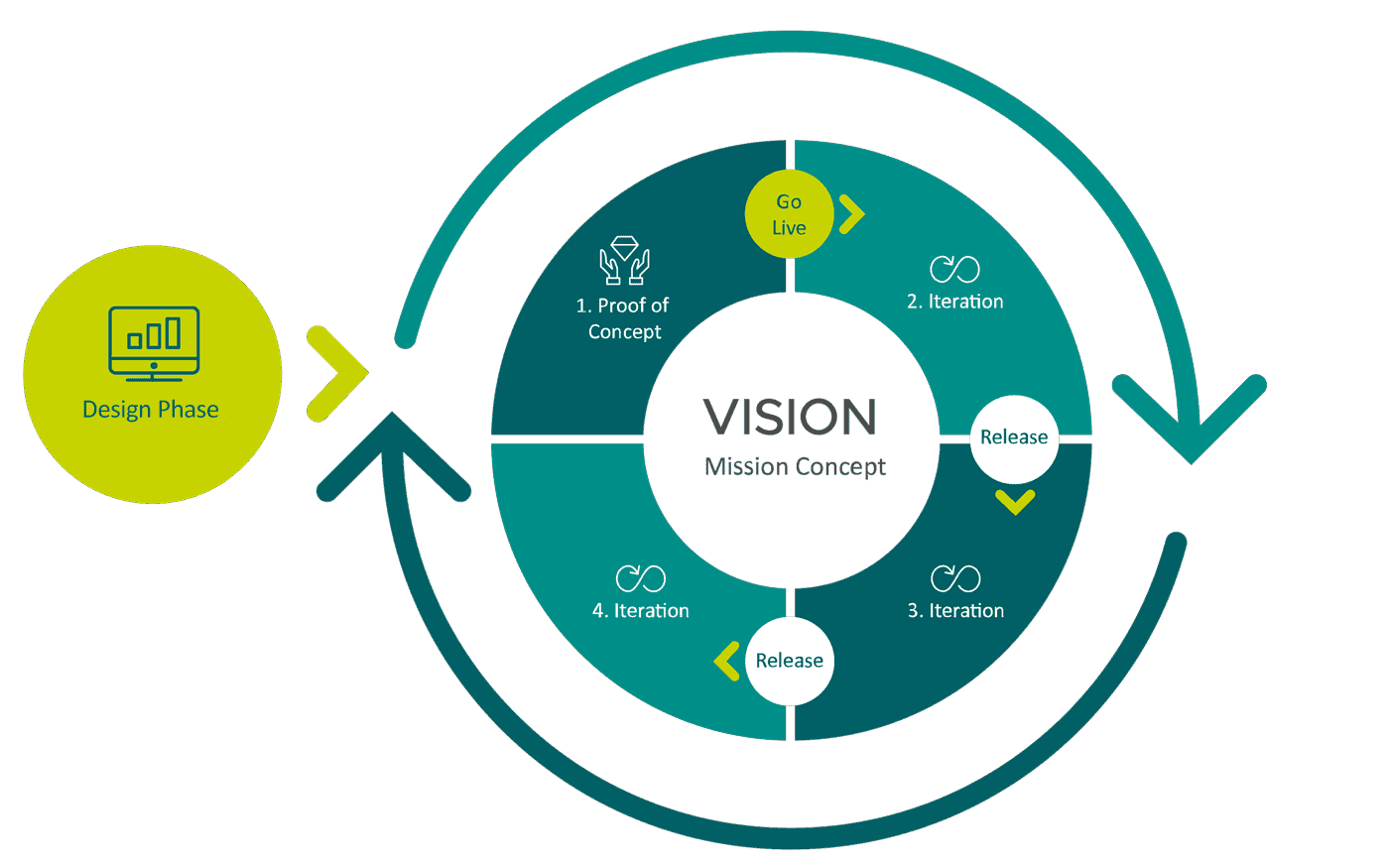The unbeatable advantages of Agile PIM
The agile implementation of PIM projects has established itself as the proven best practice. With this flexible and transparent method, you can continuously adapt your PIM strategy to keep pace with the times. This enables you to quickly create value, identify risks early on, and future-proof your product communication.
Agile PIM is not just a method, but a strategy that enables rapid value creation and optimizes your processes. The advantages are obvious:
- Rapid value creation: Through agile development, implementation, and expansion of your PIM strategy, you get productive and functional software in short, recurring cycles rather than after months.
- Continuous optimization: Agile methods promote an adaptive approach. Instead of defining processes once, they are continuously developed and optimized. New requirements that arise during the course of the project are not disruptive, but welcome.
- Early risk minimization: In conventional projects, risks are often only identified at a late stage. Thanks to the short work cycles and constant coordination in the agile method, potential problems are identified early on and can be avoided.
- Your competitive advantage: In a world where customers must constantly be addressed via new channels, state-of-the-art product communication gives you a decisive advantage. Agile PIM enables you to fully exploit potential in a timely manner.
Agile PIM Project Method & Strategy: The Power of Culture
An agile culture goes far beyond technical processes and enriches change management in your company. It promotes new, effective ways of working that are visible and improve collaboration.
- Inclusion instead of exclusion: In agile PIM projects, employees and stakeholders are involved at an early stage. This leads to rapid learning and flat learning curves, in contrast to the late involvement and steep learning curves of traditional approaches.
- High acceptance: Agile PIM makes the complex topic transparent and promotes change management by improving understanding of the requirements of all departments. This helps to complete the project successfully.
- Focused goals: With Agile PIM, you pursue your goals more consistently and achieve measurable results faster.

The agile process is visually represented by a cycle. It begins with a conception phase and a clear vision before moving into iterative phases that enable releases and ultimately go-live.
PIM by doing: How to accelerate your digital transformation
With Agile PIM, communicode AG has developed its own change management method that introduces complex data worlds and collaborative processes in manageable steps. The principle of “PIM by doing” is at the heart of this approach.
- Accelerate processes: This speeds up the process of your digital business transformation and secures your investment.
- Act in a customer-centric manner on the market: With Agile PIM, you can communicate faster, in a more customer-centric and multi-layered way. You become more visible, increase your reach, and become more attractive to your customers than the competition.
- Successful PIM projects: Product information management is a complex and never linear topic. The agile approach creates transparency and a common definition of goals, which is crucial for success.
Agile PIM versus conventional PIM implementation: A direct comparison
The advantages of agile projects become particularly clear when compared to the traditional approach:
| 1 | Focus on PIM strategy | vs | Focus on PIM system |
|---|---|---|---|
| Which individual aspects cover 80% of requirements with 20% effort? | Requirement: Detailed planning and control of PIM complexities | ||
| Advantages: Stability, acceptance, time advantage | Disadvantages: Fragility, uncertainty, loss of time |
| 2 | Software: low license costs & rental basis | vs | Software: high license costs & purchase basis |
|---|---|---|---|
| Software quickly supports your goals; final decision on software can be made later. | Goals & requirements for software become watered down or obsolete in the process. | ||
| Advantages: quick start and agile use | Disadvantages: loss of time and fragile immobility |
| 3 | Fast learning & flat learning curves | vs | Late learning & steep learning curves |
|---|---|---|---|
| Shared success & experience drive the iterative expansion of the PIM strategy. | Usually excluding important individuals and with many “nice-to-have” requirements. | ||
| Advantage: Employees are involved early on | Disadvantage: Employees are involved late |
| 4 | Distributed project risk | vs | High project risk |
|---|---|---|---|
| Individuals, requirements, and reality are always in harmony. Changes are welcome. | Unrealistic requirements lead to dead ends. Changes cause costs and frustration. | ||
| Advantage: quick response to changed factors | Disadvantage: slow response to changed factors |
| 5 | Fast return on investment & adaptive solution | vs | Late return on investment & monolithic solution |
|---|---|---|---|
| Processes and data are created as the best possible solution, taking environmental factors into account. | Solutions are already unprofitable, obsolete, or not being used to their full potential. | ||
| Advantage: Competitive advantage: 20% effort meets 80% of demand | Disadvantage: PIM project does not bring the expected success |
Ready for better results?
PIM projects are complex, but they don't have to be confusing. With an agile approach, you can stay in control and consistently achieve your goals.
We invite you to get to know us and our agile PIM project method. With our support, we will turn you into a product information management specialist who is one step ahead of the competition.
The first step toward better communication is always conversation. Let's talk about it – for a common understanding and better results.
